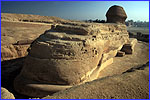|
|
 |
The most enigmatic of sculptures, the Sphinx was carved from a single block of
limestone left over in the quarry used to build the Pyramids. Scholars believe
it was sculpted about 4,600 years ago by the pharaoh Khafre, whose Pyramid
rises directly behind it and whose face may be that represented on the Sphinx.
 The Sphinx from the rear, gazing down on Cairo.
The Sphinx from the rear, gazing down on Cairo.
|
|
Half human, half lion, the Sphinx is 240 feet long and 66 feet high. Badly
eroded, it has undergone numerous restorations over the millennia, beginning
with one conducted about 1400 B.C. by the pharaoh Tuthmosis IV, who dreamt that
the Sphinx asked him to clear the sand around it in return for the crown of
Upper and Lower Egypt. The Sphinx has recently undergone a major modern
restoration.
 The so-called "dream stela" of Tuthmosis IV, which the
pharaoh placed between the Sphinx's paws about 1400 B.C.
The so-called "dream stela" of Tuthmosis IV, which the
pharaoh placed between the Sphinx's paws about 1400 B.C.
|
|
In this 180° image, as you "walk" around the Sphinx from its left side to
its right, watch the sunrise first strike the top of the Khafre Pyramid in the
background, then light up the Sphinx itself. To get a sense of the sheer size
of the sculpture, keep an eye out, too, for the man standing below it.
|


 The Sphinx from the rear, gazing down on Cairo.
The Sphinx from the rear, gazing down on Cairo.
 The so-called "dream stela" of Tuthmosis IV, which the
pharaoh placed between the Sphinx's paws about 1400 B.C.
The so-called "dream stela" of Tuthmosis IV, which the
pharaoh placed between the Sphinx's paws about 1400 B.C.